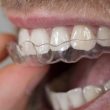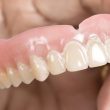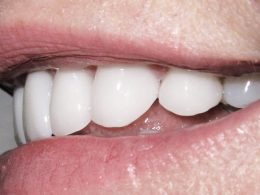Table of Contents
Fixed prosthodontics is concerned with restoring teeth through structures that are cemented or screwed into the patient’s mouth, and then cannot be removed by him. They are usually made in a laboratory after taking impressions (molds), so that the technician can work on them. That is, they are indirect restorations, since they are made outside the patient’s mouth.
Indirect restorations can be used to restore and repair individual pieces, several or all teeth at the same time, and can also be used for cosmetic purposes; to modify the shape, color and size of the teeth. These structures are much stronger and more resistant than direct obturations (fillings) and adhesive reconstructions.
It is almost impossible to determine how long fixed restorations can last in the mouth. If properly planned, executed, and maintained, they typically last between 10 and 20 years, and perhaps much longer.
Below we will show the main types of indirect restorations and the most important professional considerations to take into account when preparing teeth for their fabrication.
Crowns
Crowns are often called “dental caps”. They cover the healthy parts of the natural tooth when it has lost a large amount of structure, thus providing total or full coverage of it.
Crowns can be made from many different materials, from an all-metal gold crown to a high strength metal-free ceramic crown. The type of crown to be performed will depend on the amount of remaining structure, the location of the tooth in the arch, the type of occlusion or bite, and the patient’s preferences.
Fixed Bridges
Fixed bridges are designed to restore the gaps left in the arches after losing or extracting teeth. They can be fixed in place by preparing and grinding the teeth near the gap (tooth stumps or abutments) or they can be attached to the adjacent teeth with metal fins and a special adhesive (Maryland bridges).
In the vast majority of cases, bridges are supported by pillars at both ends of the space (conventional), but sometimes only on one side (cantilevers); depending on the size of the gap and the functional requirements of the area.
Fixed bridges can look great and look natural, however, if they are dento-supported (on natural teeth); they have the great disadvantage that they compromise or “damage” the neighboring teeth in some way, since it is necessary to wear them to fix the structure.
Inlays
A more conservative option than a crown is the inlay type incrustation. An inlay can be made if a relatively small amount of tooth tissue is missing within the limits of the tooth cusps. The inlay can be made of metal, composite or ceramic; and it is only indicated for posterior teeth (bicuspids and molars).
Its main advantage is that it provides more resistance and longevity than a direct restoration, made in the mouth by the Dentist.
Onlays
It is another type of incrustation, which often covers the cusps of a tooth. They are particularly useful if the tooth needs to be strengthened or reinforced. They can also be used to lengthen or elongate teeth, which can be useful if it is rebuilding a dentition worn by bruxism.
They are usually indicated when a posterior tooth is at risk of fracture due to loss of calcified structure (but not so large as to require a crown), or also, after a root canal treatment.
Porcelain Veneers
The aesthetic option par excellence to improve the general appearance of the dentition or correct existing defects with conservative restorations that recreate the natural appearance of the teeth and provide resistance comparable to tooth enamel.
Veneers or porcelain facets are thin ceramic sheets between 0.8 and 1.5 mm thick that, adhered to the front surface of the teeth, are capable of completely modifying their shape, texture, color and size.
They are mainly used in smile designs to achieve a radical change in the teeth and facial appearance.
Veneers can also be made of composite, however, they only represent an inexpensive and simplified version of porcelain veneers. In addition, they are made with a direct adhesion technique, therefore, they do not constitute a true fixed prosthesis procedure.
Dental Implants
In addition to the 5 types of restorations described above, all belonging to the classic procedures of conventional fixed prosthesis (over natural teeth), today it is also routine to perform crowns, bridges and complete dentures over dental implants:
- Implant-Supported Crowns Although clinical and laboratory work is much more complex than that of a dento-supported cap or crown, it is the most basic restoration that can be realized over an osseointegrated implant. They are indicated in cases of unitary implants and can be made of metal-porcelain, lithium disilicate or zirconium oxide (high dental aesthetics).
- Implant-Supported Bridges It is the ideal fixed option for edentulous gaps of 3 or more contiguous teeth. The structure is made up of 3 or more crowns fused together and supported at their ends by 2 or more dental implants. They can be made with the same materials that are used for the individual crowns, and like them, they can be fixed with cement or with screws to the implants.
- Hybrid Prosthesis A hybrid prosthesis is one that combines several materials. It is a single fixed structure that screws onto 4, 6 or 8 implants and generally replaces all the teeth in an arch. It can be made of metal-porcelain or metal-acrylic, and in cases of maxillary atrophy or severe bone resorption, it incorporates pink artificial gingiva to reestablish the vertical occlusal dimension, lip support, dental aesthetics and facial fullness of the person.
Preparation Techniques for Conventional Crowns and Bridges
The preparation of a tooth for a crown or fixed bridge pillar, involves the irreversible removal of a significant amount of its dental structure (carving of tooth stumps). Therefore, it should only be carried out on the basis of a good diagnosis and treatment plan, which guarantees to be the best therapeutic option for the patient.
Typically, more than one office visit is required to complete crown and bridge work. Next, we will see the main characteristics associated with the most time-consuming procedure in this type of treatment: the preparation of the teeth or tooth stumps carving.
Carving Characteristics
When approaching a tooth for a crown, the preparation should, ideally, involve only the enamel. As explained below, the amount of dental structure that must be removed, will always depend on the material that it is used to restore the tooth.
If the tooth is to be restored with a full gold crown, the preparation should only be 0.5 mm thick (since gold is very strong) and, therefore, only that space should be provided for the crown. If porcelain is to be applied over the gold, then an additional 1 mm (1.5 mm total) of healthy tooth structure must be removed, to allow adequate porcelain thickness; without over-contouring the crown or generating a taller and thicker restoration than the natural tooth. For metal-free porcelain or ceramic crowns, the amount of tooth reduction should be approximately 2 mm.
If there is not enough dental structure to properly retain the artificial crown, the tooth will require a previous reconstruction, as long as its root is in good biological condition.
This can be achieved with direct reconstructions made with pins, amalgam or composite, for the simplest cases. However, if the destruction is significant, root canals will need to be done to accommodate posts in the root canals (inside the root) and achieve adequate retention of the coronal portion. At present, basically 2 types of posts are used: fiberglass-based prefabricated ones and custom-made castings in the dental laboratory.
Preparation Taper
The prepared tooth must also possess a certain degree of taper to allow correct and easy insertion of the artificial restoration. Similarly, there should be no cuts or irregularities on the surface of the carved tooth, as they would make it impossible to settle and adjust the structure.
However, an excessive taper would severely limit the retention of the crown, since it would generate an expulsive preparation. Generally, 3° of occlusal convergence around the entire circumference of the prepared tooth, generating a global convergence of 6° in any sagittal section of the same, is appropriate to allow the crown to fit easily and precisely; without compromising its retention.
Margin or Termination Line
The most gingival portion (closest to the gum) of the dental preparation, is called the margin or termination line. The interface (junction surface) tooth-restoration will be located at the level of this line, therefore it must be smooth and well defined so that the crown, no matter what material it is made of, can adapt perfectly to it; without irregularities, undercuts or over-contours.
Inevitably, at the microscopic level, there will always be a small separation at the level of that interface, but it should never be greater than between 40 and 100 nm, the clinically acceptable parameter. Interfaces greater than these values, are likely to generate microfiltration and restoration failure.
Another important consideration about the termination line, is its location in relation to the gum. In posterior teeth, it should be supragingival, that is, above the gingiva. However, in anterior teeth, for aesthetic reasons, it is usually necessary to place it below it (subgingival); to avoid exposing the tooth-restoration interface during the smile.
Sometimes, it is necessary to surgically cut or reshape the gingiva, so that the correct placement of the termination line is allowed and all the aesthetic goals of the procedure can be met.
There are different types of termination lines, which are defined based on the type of crown, material and total thickness of the restoration. The termination in chamfer is used for thinner metal crowns and shoulder termination for metal-porcelain and full-ceramic crowns. When using a shoulder preparation, it is often suggested to add a bezel to dissipate the concentration of forces and reduce interface space. In this case, the name of the preparation would be beveled shoulder.
Ferrule Effect
This term is commonly referred to when allusion is made to the remaining tooth structure located on the termination line of the prosthetic preparation. However, the ferrule effect is defined as the true guarantee that the dental structure offers to the support of the prosthetic crown. That is, the resistance to fracture provided by the remaining tooth structure.
Most authors agree that ferrule height is a determining factor in the longevity of endodontic tooth restorations. They state that a 1 mm vertical ferrule doubles the resistance to fracture, compared to teeth lacking it. Also, they indicate a ferrule height of 1.5 mm as the ideal to support full coverage metal crowns over casting posts.
Biologic Width
The biologic with or dentogingival junction is an area or structure formed by the junctional epithelium and the connective tissue of the gum, that is, it represents the junction between the tooth and the gum. When talking about the biologic with, not only the length of that union should be considered, but it should be related to the thickness of the gingiva, the periodontal biotype and the depth of the gingival sulcus; since all these parameters are integrated and must be taken into account when preparing pillars for fixed prosthodontics.
The relationship between periodontal health and tooth restoration is intimate and inseparable. Maintaining gingival health is one of the keys to tooth and dental restoration longevity. A proper understanding of the relationship between periodontal tissues and restorative Dentistry is essential to ensure the shape, function and aesthetics of the smile.
The importance of this anatomical-functional structure lies in the consequences that can be derived from its invasion.
The invasion of the biologic width sometimes occurs because when performing the prosthetic preparation of a tooth, the margin of the same extends beyond what is biologically acceptable. The consequences of invading the biologic width are: accumulation of a greater amount of bacterial plaque, inflammation of the gingiva, formation of periodontal pockets, hyperplasia, gingival recession and localized periodontitis.
For this reason, it is always advisable to have this type of treatment with Dentists Specialists in Prosthodontics, since they know precisely how far the dental preparation should extend, depending on the patient’s gum type.
“Although Almost All General Dentists Do Fixed Prosthesis, the Most Recommended Thing Is to Put Yourself in the Hands of a True Specialist in Prosthodontics”.
DENTAL TIP
Come to Venezuela and Forget About Removable Dentures!
Never forget that dental tourism is an extraordinary tool for accessing top-notch Dentistry.
DENTAL VIP trusts that quality of dental care should be affordable to all, no matter where you live. Hundreds of patients come to Venezuela for state-of-the-art medical and dental care every year, saving large amounts of money on health. Our rates are significantly lower than in any other Latin American country (up to 70% off), without it implying a decrease or compromise in the quality of service. Our Professional Staff is one of the best in the country and has extensive experience in dental and zygomatic implants, metal-free crowns and bridges, oral rehabilitation, smile design and cosmetic Dentistry.
We guarantee that by using the services offered by DENTAL VIP, you will be cared for in modern facilities, with state-of-the-art equipment and under the standards of the most demanding international dental protocols.
Come for the price and stay for the quality! Contact us today through WhatsApp +58 414-9033547 or Email and we will let you know, according to your case, all the evaluations and basic studies required for your treatment.












